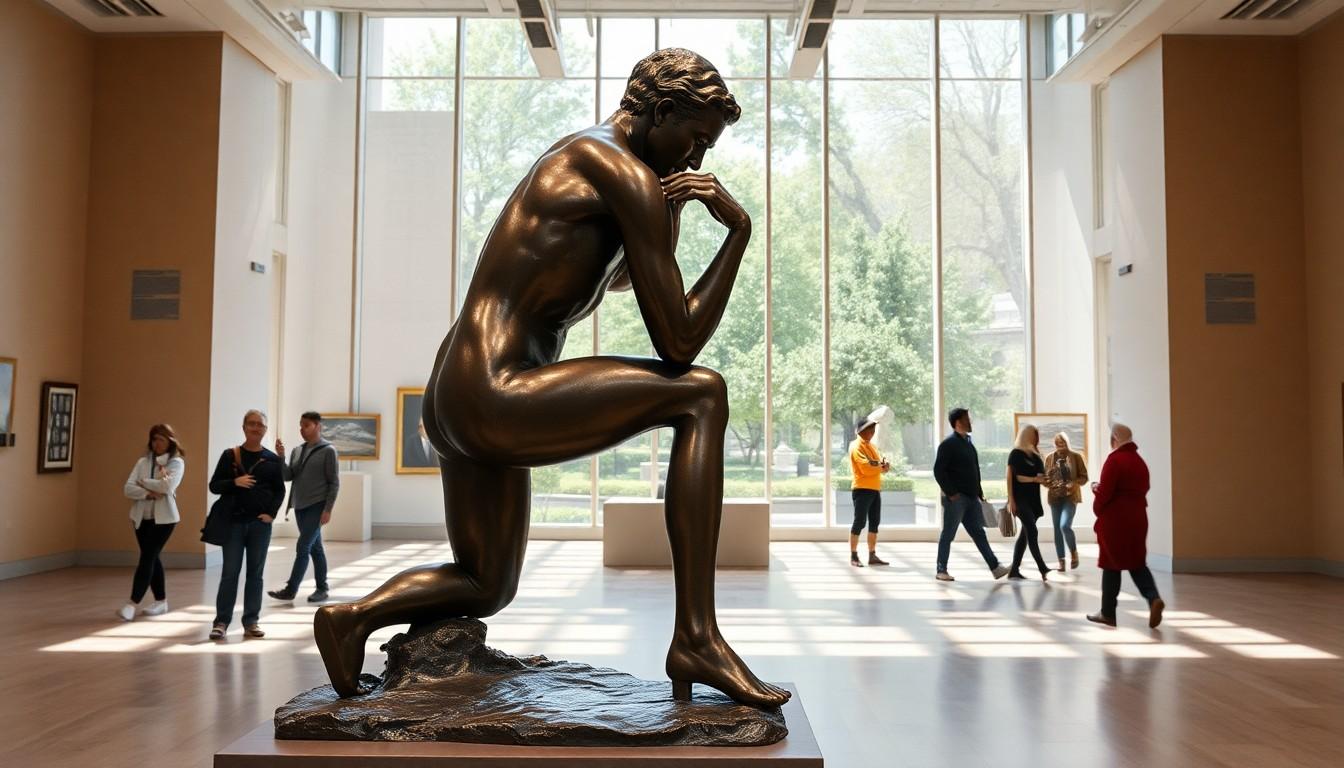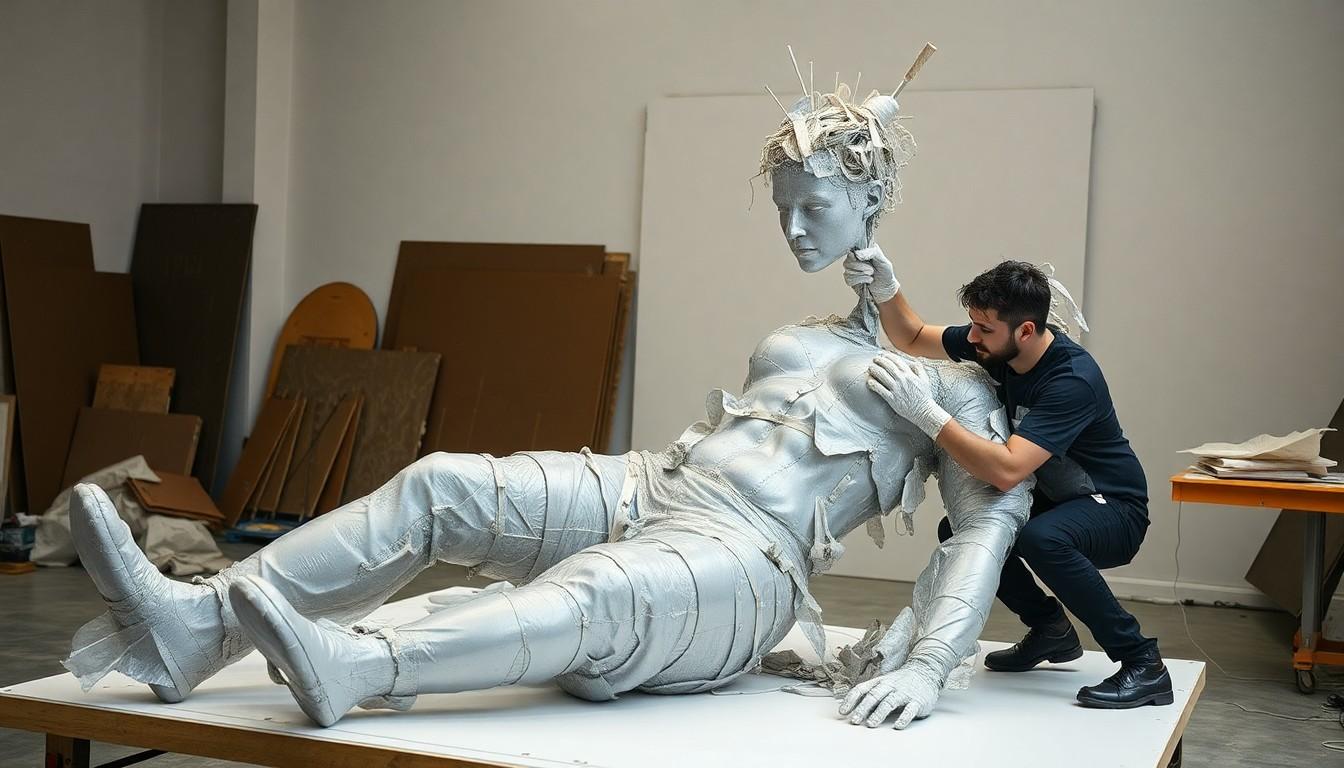
Figurative Sculpture: Discover the Emotional Power Behind Life-Sized Artworks
Figurative sculpture isn’t just about chiseled stone and metal; it’s where art meets the human experience in a three-dimensional hug. Imagine walking through a gallery and encountering a life-sized figure that seems to whisper secrets of its creator. These sculptures capture emotions, stories, and sometimes even a bit of humor, all while standing still.
From classical masterpieces to contemporary creations, figurative sculpture invites viewers to ponder the human condition. It’s like a silent conversation with the artist, revealing layers of meaning that words often fail to express. So, whether you’re an art aficionado or just someone who appreciates a good statue, dive into the captivating world of figurative sculpture and discover how these works can inspire, provoke thought, and maybe even make you chuckle.
Figurative Sculpture
Figurative sculpture represents the human form and experience, spanning various styles and periods. Artists create lifelike representations, capturing movement and emotion. This genre ranges from classical Greek sculptures to modern pieces by contemporary artists.
In classical art, sculptors emphasized idealized beauty, reflecting societal values and aspirations. Works like Michelangelo’s “David” showcase technical mastery and deep understanding of anatomy. Contemporary artists, on the other hand, often challenge traditional forms and concepts. They employ mixed materials and innovative techniques, making statements about identity and culture.
The interaction between viewer and sculpture enhances the emotional experience. Sculptures can evoke personal reflections or provoke social commentary. They exist not only as aesthetic objects but also as vessels for storytelling and connection.
Public installations raise awareness, inviting community engagement. Iconic examples include the “Fearless Girl” statue in New York City, promoting gender equality. Such works often invite dialogue and foster change.
Figurative sculptures vary significantly in materials and techniques. Creators use stone, metal, wood, and clay, each offering unique aesthetic qualities. The choice of medium influences the final impact of the piece, whether it’s a polished bronze statue or a rough-hewn wood figure.
Overall, figurative sculpture continues to evolve, pushing boundaries while retaining its core focus on the human experience. Artists draw from history and personal narratives to create compelling works that resonate with audiences today.
Historical Context
Figurative sculpture has deep historical roots, evolving through time and reflecting cultural changes. Its development spans from ancient civilizations to contemporary art movements.
Ancient Figurative Sculpture
Ancient figurative sculpture emerged in societies like Greece, Egypt, and Mesopotamia. Greek artisans captured human anatomy and emotion through lifelike forms, with pieces such as the Parthenon sculptures showcasing idealized beauty. Egyptian sculptures served distinct purposes, often appearing in tombs to honor deities and preserve the deceased’s image. Mesopotamian artists created narrative reliefs that depicted gods and royalty, emphasizing power and mythology. These early works established foundational techniques and thematic elements, influencing generations of sculptors.
Modern Interpretations
Modern interpretations of figurative sculpture reflect diverse perspectives and techniques. Contemporary artists often challenge classical concepts by incorporating unconventional materials, such as plastics and found objects. Sculptures like “The Kiss” by Alberto Giacometti emphasize existential themes, while others, like Marc Quinn’s “Self,” use self-portraiture to explore identity. Many modern artists aim to provoke thought and dialogue, pushing boundaries of form and context. This evolution continues to resonate, inviting audiences to engage with the human experience creatively.
Techniques in Figurative Sculpture
Figurative sculpture employs various techniques, blending creativity with craftsmanship. Artists utilize multiple materials and sculpting methods to create lifelike representations.
Materials Used
Common materials in figurative sculpture include stone, metal, wood, and clay. Each material has unique properties that influence the final artwork. For example, marble and granite offer durability, allowing for intricate details and lasting pieces. Bronze and steel provide strength, enabling larger installations that often grace public spaces. Artists frequently use wood for its warmth and organic feel, while clay serves as a versatile medium for smaller works. The selection of material plays a critical role in expressing emotions and themes within the sculpture.
Sculpting Methods
Several sculpting methods shape the production of figurative sculptures. Carving remains among the oldest techniques, where artists remove material from a solid block to reveal the form. Modeling, on the other hand, involves shaping malleable materials like clay, allowing for adjustments during the creative process. Casting captures details with precision; it involves pouring liquid material into a mold, producing replicas of the original sculpture. Assemblage combines various elements, encouraging experimentation and innovation in form. Each method provides distinct advantages, allowing artists to explore creativity and convey complex narratives through their works.
Notable Figurative Sculptors
Figurative sculpture showcases a diverse range of talent, highlighting both contemporary artists and influential masters.
Contemporary Artists
Contemporary figurative sculptors breathe new life into traditional forms. Artists like Antony Gormley utilize the human body to explore themes of existence and identity. Damien Hirst’s works often merge figurative elements with conceptual ideas, creating pieces that challenge perception. Yinka Shonibare employs historical and cultural references to address issues of colonialism through his distinctive installation art. Additionally, Kiki Smith focuses on human experience and bodily form, often incorporating organic materials to evoke emotional responses. These artists represent a vital part of today’s artistic landscape and engage audiences in thought-provoking dialogues.
Influential Masters
Influential masters laid the groundwork for modern figurative sculpture. Michelangelo, renowned for his mastery of marble, produced iconic works like “David” that emphasize human anatomy and emotion. Auguste Rodin revolutionized sculpture with dynamic forms and textures, epitomized in “The Thinker.” Alberto Giacometti’s elongated figures convey existential themes, reflecting human isolation and connection. Henry Moore, known for his abstracted representations, celebrated the human figure through organic shapes and large-scale installations. Each of these artists significantly impacted the evolution of sculpture, shaping how future generations interpret the human form.
The Impact of Figurative Sculpture
Figurative sculpture significantly influences culture and society. It evokes emotions and prompts reflections on human experiences. Through lifelike representations, artists express themes of identity, existence, and community interactions.
Public installations serve as powerful vehicles for social commentary. The “Fearless Girl” statue in New York City exemplifies how art can inspire change and encourage public dialogue. Community engagement often flourishes around such pieces, fostering conversations on relevant issues.
Material selection plays a crucial role in conveying impact. Artists utilize stone, metal, wood, and clay, each offering distinct attributes that shape the artwork’s narrative. For example, bronze and steel lend themselves well to larger public works, while marble captures intricate details effectively.
Viewer interaction amplifies the emotional experience. Engaging with sculptures fosters personal connections, leading to heightened awareness of societal themes. Observing figures in various settings creates opportunities for interpretation that resonate deeply with diverse audiences.
Contemporary artists continuously challenge traditional notions of figurative sculpture. Innovative uses of mixed materials and themes push boundaries and provoke discussions around cultural identity. Works by artists like Yinka Shonibare exemplify this trend, inviting critical examination of heritage and representation.
The historical significance of figurative sculpture remains paramount. From ancient civilizations to contemporary artistry, these sculptures reflect shifts in societal values and beliefs. Each era’s approach offers insight into the human condition, bridging historical gaps through artistry.
Overall, figurative sculpture serves as a dynamic force in the art world, nurturing connections between viewers and the human experience. Through diverse expressions, it remains relevant and impactful, encouraging ongoing dialogue and reflection.
Tradition and Innovation
Figurative sculpture stands as a powerful testament to the human experience. Through its diverse forms and materials, it invites viewers to engage with emotions and narratives that resonate deeply. The evolution from classical to contemporary styles showcases a rich dialogue between tradition and innovation.
Each piece not only reflects the artist’s vision but also encourages personal reflection and social discourse. As contemporary artists continue to push boundaries, figurative sculpture remains a vital medium for exploring identity and culture. Its ability to connect people and provoke thought ensures its enduring relevance in the art world.
